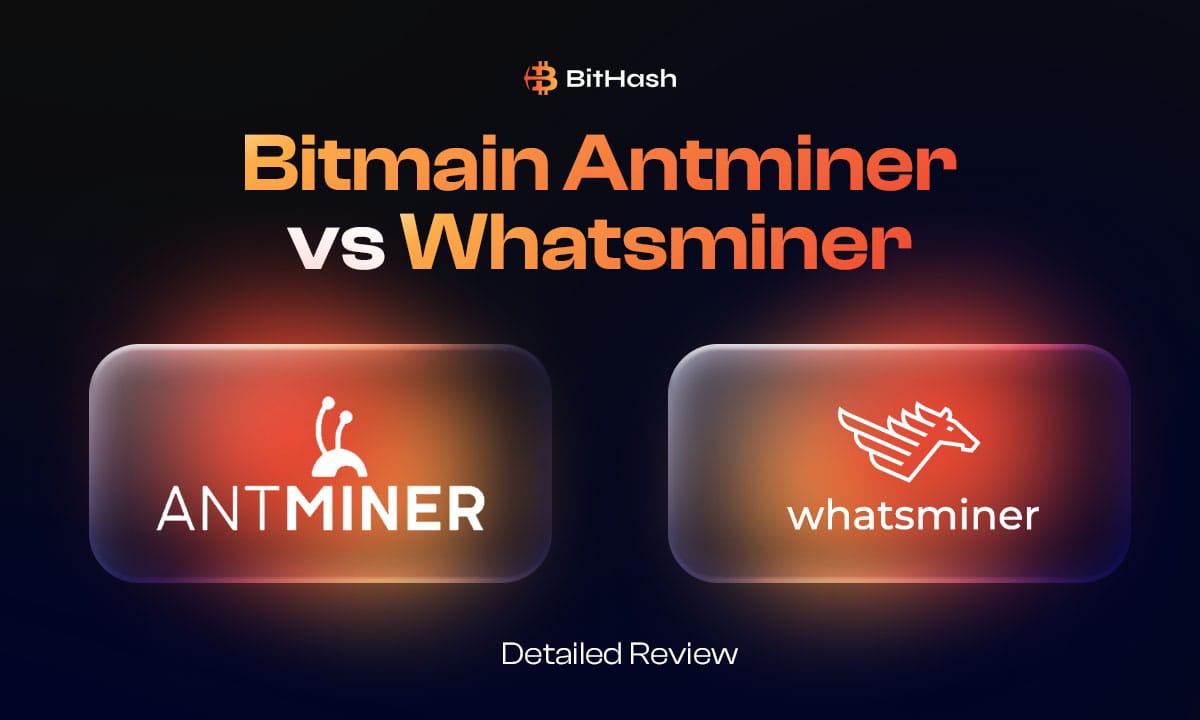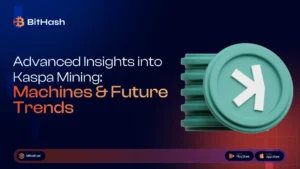When it comes to Bitcoin mining, choosing the right ASIC miner is crucial for maximizing profitability. Two of the most dominant players in the industry are Bitmain’s Antminer series and MicroBT’s Whatsminer series. Both brands are known for producing high-performance mining rigs, but they differ significantly in efficiency, power consumption, cooling mechanisms, and overall reliability.
Whether you’re a small-scale miner looking for cost-effective options or a large-scale operation prioritizing efficiency, understanding the strengths and weaknesses of each brand can help you make an informed decision.
In this detailed review, we’ll compare the latest models from both series, analyzing their hash rates, power efficiency, noise levels, and pricing to determine which miner best suits your mining needs.
1. Overview of Bitmain Antminer Series
Bitmain stands as one of the most well-known manufacturers of ASIC miners, with its Antminer series being a favorite among miners worldwide. These powerful mining hardware units are designed to deliver maximum performance while optimizing energy efficiency, a critical factor given today’s rising electricity costs.
As the Bitcoin network’s difficulty continues to climb, the importance of efficient mining equipment has never been greater. Bitmain’s Antminer lineup, from the legendary S9 to the cutting-edge S21 series, has consistently pushed the boundaries of hash rate and power efficiency. The company’s dominance in the ASIC market stems from its vertical integration, allowing for optimized chip design and manufacturing. Recent models like the S19 XP and S21 Hyd demonstrate Bitmain’s commitment to innovation, particularly in cooling solutions that enhance both performance and longevity.
Moreover, for professional mining operations, Antminers offer the reliability and consistent firmware updates needed for uninterrupted operation. While the premium pricing may deter some hobbyist miners, the superior efficiency often justifies the investment through lower operational costs over time. As environmental concerns grow in the mining sector, Bitmain’s focus on energy-efficient designs positions its hardware as future-proof solutions for sustainable cryptocurrency mining.
Key Antminer Models:
- Antminer S19 XP Hyd. (255 TH/s) – A hydro-cooled beast with extreme efficiency, perfect for large-scale mining farms looking to push hash rates to the limit.
- Antminer S21 (200 TH/s, 17.5 J/TH) – An air-cooled ASIC miner that sets a new standard in energy efficiency, making it ideal for miners focused on long-term profitability.
- Antminer S19j Pro+ (122 TH/s, 29.5 J/TH) – A reliable workhorse for mid-range operations, balancing power and affordability for those with moderate electricity costs.
- Antminer T21 (190 TH/s, 19 J/TH) – Optimized for low-power mining environments, this model helps miners reduce operational expenses without sacrificing performance.
Each of these ASIC miners is engineered to provide optimal hash rates while minimizing energy waste, ensuring you get the best return on investment in today’s competitive mining landscape.
Pros of Antminer:
✔ Higher efficiency in newer models (e.g., S21 at 17.5 J/TH).
✔ Trusted brand with strong market presence.
✔ Better firmware support with frequent updates.
✔ More resale value due to brand reputation.
Cons of Antminer:
❌ Expensive upfront cost compared to some Whatsminer models.
❌ Loud fans in air-cooled models.
❌ Limited availability during high-demand periods.
2. Overview of MicroBT Whatsminer Series
MicroBT has emerged as a formidable competitor in the cryptocurrency mining sector with its Whatsminer series, challenging Bitmain’s long-standing dominance in the ASIC miner market. These robust bitcoin mining hardware solutions have gained popularity by offering miners an attractive balance of performance and affordability.
Additionally, the company’s rapid rise can be attributed to its focus on delivering competitive hash rates at price points that often undercut comparable Antminer models, making Whatsminers particularly appealing to cost-conscious operations. MicroBT’s product line demonstrates consistent innovation, with each new generation showing improved thermal management and power efficiency.
Furthermore, Models like the M30 and M50 series have proven especially popular among mid-sized mining farms looking to maximize their hash rate per dollar invested. The company has also made strides in noise reduction, with some Whatsminer models operating noticeably quieter than their Antminer counterparts, an important consideration for miners with space constraints.
Key Whatsminer Models:
- Whatsminer M60 (270 TH/s, 22 J/TH) – While slightly less efficient than the flagship Antminer S19 Pro, this model delivers an impressive hash rate that makes it ideal for large-scale operations with access to affordable power.
- Whatsminer M50 (126 TH/s, 26 J/TH) – A strong mid-range option that balances performance and power consumption, perfect for miners upgrading their bitcoin mining hardware setups.
- Whatsminer M30S++ (112 TH/s, 31 J/TH) – Though older, this workhorse remains popular in the secondary market for miners entering cryptocurrency mining on a budget.
- Whatsminer M56 (230 TH/s, 22 J/TH) – Designed to compete directly with newer models like the Antminer T21, offering comparable efficiency for serious mining operations.
These Whatsminer models demonstrate MicroBT’s commitment to providing reliable bitcoin mining hardware that can compete with Bitmain’s offerings across different price segments and performance tiers in the competitive cryptocurrency mining landscape.
Pros of Whatsminer:
✔ Lower upfront cost in some models.
✔ Better cooling systems (quieter than Antminers in some cases).
✔ Good performance-to-price ratio for budget-conscious miners.
✔ More stable power delivery in some models.
Cons of Whatsminer:
❌ Slightly less efficient than latest Antminers.
❌ Fewer firmware updates compared to Bitmain.
❌ Resale value may be lower than Antminers.
3. Head-to-Head Comparison
Feature | Antminer S21 (200 TH/s) | Whatsminer M60 (270 TH/s) |
| Hash Rate | 200 TH/s | 270 TH/s |
| Power Efficiency | 17.5 J/TH (Better) | 22 J/TH |
| Power Consumption | ~3500W | ~5940W |
| Cooling | Air-cooled | Air-cooled |
| Noise Level | High | Moderate-High |
| Price (Approx.) | $3,500 – $4,500 | $3,000 – $4,000 |
| Best For | Efficiency-focused miners | High hash rate seekers |
Which One is Better?
When choosing between these top-tier ASIC miners, your decision should factor in current mining difficulty, electricity costs, and your preferred cooling solutions:
1. For Maximum Efficiency & Long-Term Profitability
The Antminer S21 (and its predecessor Antminer S21 Pro) wins decisively with its industry-leading 17.5 J/TH efficiency. This makes it ideal for:
- Operations facing rising mining difficulty
- Miners with higher electricity rates
- Those planning for sustainable operations as block rewards halve
2. For Raw Hash Power at Lower Entry Cost
The Whatsminer M60’s 270 TH/s output shines when:
- Electricity costs are below $0.07/kWh
- You need immediate hash rate to compete in cloud mining pools
- Your facility can handle its higher power demands
3. Cooling Considerations:
- The Antminer S17 generation showed the limitations of air cooling in modern miners
- Newer immersion cooling and hydro cooling solutions work exceptionally well with both brands
- Whatsminer’s chassis designs often adapt better to alternative cooling solutions
Pro Tip: For large-scale operations, pairing the S21 with hydro cooling can achieve unmatched efficiency, while the M60 may be better suited for traditional air-cooled warehouses in cooler climates.
This enhanced comparison helps miners evaluate not just specs, but real-world deployment scenarios as mining conditions evolve.
4. Final Verdict: Which Should You Buy?
The choice between Antminer and Whatsminer ultimately depends on your mining strategy, power usage costs, and operational setup. Whether you’re focused on SHA-256 mining algorithms for Bitcoin or exploring dual-coin mining opportunities, each brand offers distinct advantages.
Choose Antminer If:
- ✅ You prioritize energy efficiency (lower J/TH): Crucial as mining algorithms grow more competitive.
- ✅ You want better firmware support and higher resale value: A key factor for long-term ROI.
- ✅ You’re willing to pay a premium for reliability: Proven performance in large-scale farms like Wild Rose Mining.
- ✅ You need optimized power usage: Lower electricity costs mean better profit margins over time.
Choose Whatsminer If:
- ✅ You need a higher hash rate at a lower upfront cost. Ideal for scaling quickly without massive capital.
- ✅ You prefer quieter operation (in some models), Better for urban or noise-sensitive environments.
- ✅ You’re mining in a cooler environment, where efficiency differences have less impact on power usage.
- ✅ You’re exploring dual-coin mining, some models handle alternative coins more flexibly.
Conclusion
Both Bitmain Antminer and MicroBT Whatsminer produce excellent ASIC miners, but the best choice depends on your mining setup, electricity costs, and budget.
- For most miners, the Antminer S21 is the best balance of efficiency and performance.
- If you need raw hash power at a lower price, the Whatsminer M60 is a strong alternative.
Ultimately, the decision comes down to your specific mining conditions and financial goals.





